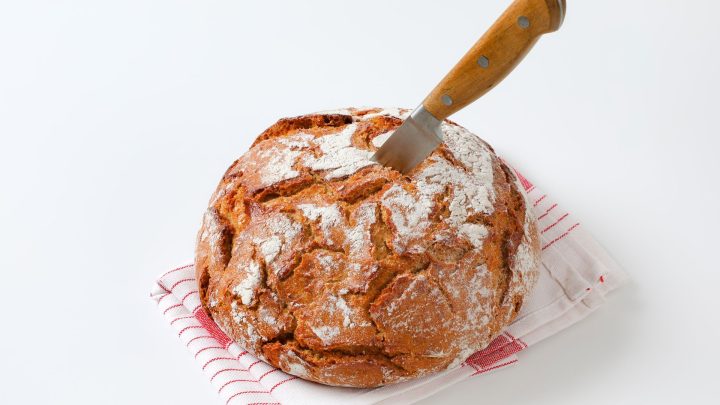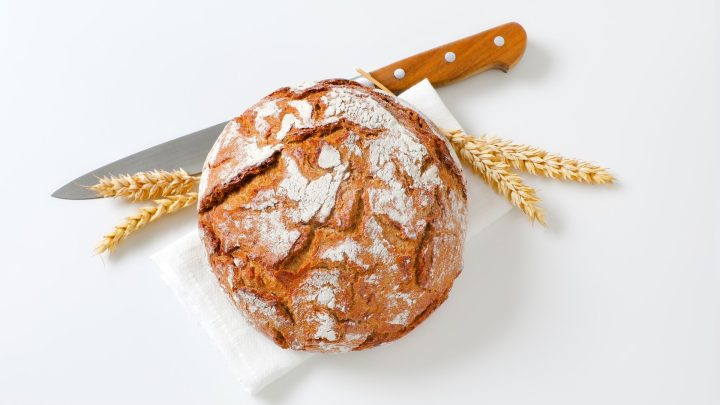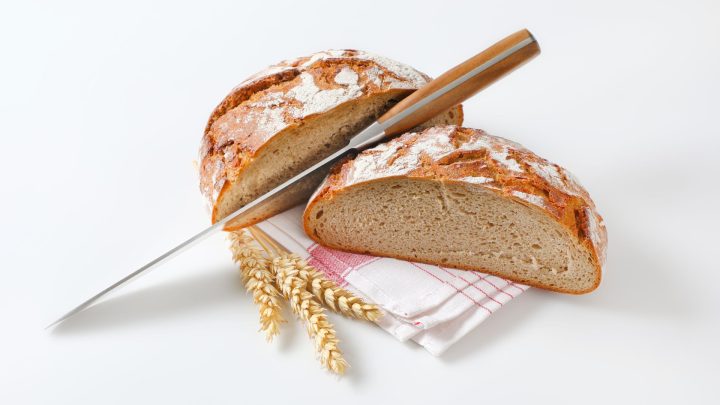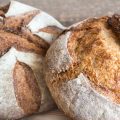Is your sourdough crust too hard? Discover the art of achieving perfect sourdough bread with a super soft crust, perfect for enjoying at breakfast. We’ll create a distinction between a crispy crust and a softer crust, ultimately leading to sourdough bread with an incredibly soft crust that can be enjoyed with melted butter and a steaming cup of tea or coffee.

Table of Contents
- Why Is My Sourdough Bread Crust So Hard?
- How Do You Fix Tough Sourdough?
- How To Make A Soft Sourdough Crust?
- You Can Achieve a Soft Sourdough Crust
- FAQs
Why Is My Sourdough Bread Crust So Hard?
If you find that your baked sourdough bread has a tough crust, with a thick texture, this may be a result of several factors:
Insufficient Gluten Development
Gluten is a protein that forms when flour is combined with water and kneaded. It provides structure and elasticity to the dough, which is extremely important for capturing the gasses produced during fermentation, essentially resulting in a light and airy loaf, with a good oven spring.
If the gluten structure within the sourdough is not developed, the dough may not be able to trap enough gas during fermentation, leading to a dense crumb with a harder crust.
To improve gluten development, make sure that there is sufficient kneading, stretching, and folding during bulk fermentation. A proper gluten structure will help create an open crumb with a softer crust.
Moisture Loss During Baking
As the dough is exposed to lots of heat in the oven, the moisture in the dough will evaporate. This process is better described as oven spring and is quite an essential step in crust formation.
However, if the moisture loss is too quick or excessive, it may result in a thick, rigid crust. This is due to the exterior of the bread becoming dehydrated, causing the crust to form before the interior of the dough has expanded.
Insufficient Cooling Time
Once the bread is removed from the oven, it continues to bake internally due to the extreme heat. If we were to cut the bread too soon, without it cooling properly, then several things can happen.
Firstly the heat can cause moisture to migrate from the crumb to the crust, resulting in a hard crust during the cooling phase.
Cutting the bread too soon can also trap steam inside the loaf, leading to a chewy and unappetizing crust texture.
Enabling the bread to cool completely will allow the bread to cool and set properly, which helps avoid a gummy and undercooked interior.
Once your sourdough bread has been baked, ensure that you remain extremely patient before slicing. Set the loaf on a cooling rack to cool for 2 hours max before slicing and devouring.
This is a great way to ensure that the bread crust remains crisp on the outside, and tender on the inside.
Inadequate Steaming
Steam is your dough’s best friend when it comes to bread baking. The steam maintains surface moisture, therefore delaying crust formation and enabling the bread to expand completely.
Without steam, you’ll create a premature crust around the dough, delaying proper expansion.
More steam creates a desirable crust, so utilizing a Dutch oven, or filing a tray with water and placing it at the bottom of the oven rack, directly beneath your sourdough results in better bread with a great tender and flavorful crust.
Exposed Dough During Final Proof
While the sourdough rests and ferments, you may risk the surface of the dough drying out, leading to a dry, rigid layer that compromises proper expansion during the initial stages of making bread.
Insufficient oven spring results in a less airy crumb and reduced volume. Similarly insufficient humidity during the proofing process can lead to less crispiness and tenderness of the dough.
To avoid this, cover the dough with a damp towel, tea towel or plastic wrap during the final proof, which will help maintain more moisture required for optimal fermentation, therefore achieving a delightful crust texture during baking.
How Do You Fix Tough Sourdough?
If you’ve ever found yourself stuck with a tough sourdough crust, then there are a few solutions to consider.
Some of the most effective methods that have helped me during my sourdough baking are outlined below.
Cover Baked Loaf While Cooking
Initially, covering a baked loaf while cooling won’t completely fix a tough sourdough crust, although it helps retain sufficient moisture, as well as prevents the crust from becoming too hard while cooling.
To avoid a hardened crust, work on the gluten development through kneading, or stretching and folding. Moreover, adjust the baking time and temperature to control moisture loss and prevent the crust from hardening.
Place the bread on a wire rack to cool, and this should help achieve a soft and tastier crust.
Line The Loaf With a Damp Paper Towel
Introducing more moisture to the bread can help soften the crust of your sourdough bread.
The damp paper towel creates a humid environment around the loaf, which enables the crust to absorb moisture, which eventually softens it. This method works best for crusts that have become quite hard during the cooling process, or for loaves that were baked without enough steam.
Try not to be excessive with the damp paper towel, as you can risk the crust becoming a tad too soft or soggy. The goal is to add just enough moisture so that the dough develops a softer crust without compromising the texture and flavor.
Puncture The Crust With Many Holes
Puncturing a sourdough crust with tiny holes can release trapped steam, which can potentially fix a hardened crust.
A hard crust suggests less steam escaping while a sourdough bread bakes, which leads to a dense and tough texture.
The holes allow steam to escape, which softens the crust and allows the crumb to expand appropriately.
It’s important to be gentle during this method, as you may risk damaging the crumb.

How To Make A Soft Sourdough Crust?
There are many ways to go about this. From ensuring proper gluten development to utilizing techniques that entrap heat for a softer crumb, and a chewy crust.
Take a look at the methods outlined below:
Soak Flour With Water
Soaking flour with water before adding the sourdough starter and salt can help create a soft sourdough crust.
During the resting phase, the flour hydrates, encouraging better gluten development.
The improved gluten structure results in a tender and elastic crumb, while higher hydration dough leads to a more softer, open crumb, and a better crumb texture.
Moreover, the dough’s elasticity improves, making shaping easier, and reducing the risk of a potentially toughened crust.
Achieve a Windowpane At The End of the First Rise
The windowpane technique involves gently stretching the dough until it becomes translucent without tearing.
A successful test will indicate a strong gluten network, which is extremely essential for gas retention during fermentation.
This creates a well-shaped loaf, with a softer crust, good oven spring, and a lighter, airer crumb.
Use Fat In The Sourdough Recipe
Creating an enriched loaf helps soften the crust by enhancing the tenderness and moisture in the loaf.
Adding butter, or oil provides a rich and wonderful texture. During baking the facts act as a barrier by slowing down moisture evaporation from the crust, therefore preventing hardening.
As well as this, the fats help create a more enhanced flavor profile, resulting in a delicious loaf.
Shorten Baking Time
Shortening the baking time prevents excessive moisture loss during baking.
When the sourdough spends less time in the oven, it’s given a limited opportunity to become dry and hard.
The idea is to ensure the dough’s interior retains enough moisture, leading to a tender crumb, ultimately preventing the crust from becoming too tough.
Boost Your Oven Spring
Boosting oven spring contributes to a soft crust by promoting expansion and achieving a lighter texture.
During oven spring the dough rises and expands while baking. A strong oven spring indicates that the dough has captured and retained enough gas during the fermentation process, which results in an airy crumb and softened texture.
A thinner crust is also a direct result of a good oven spring, as well as proper shaping, encouraging optimal gas retention. These factors combine to create a wonderful crust for your sourdough bread.
Perfect Your Starter
Essentially, perfecting your sourdough starter is extremely important for creating that soft sourdough crust. A healthy starter encourages strong fermentation, ultimately leading to better gluten development and gas production during proofing and baking.
You may choose to use a mature sourdough starter instead of a sourdough starter that is simply well-fed and active, simply because it has fermented for longer, contains more flavor, and ultimately sets the foundation for a better sourdough crust.
Use High Protein Flour
High protein flours such as bread flour, all-purpose flour, or whole wheat flour, are great for creating a soft sourdough crust.
This is simply due to the fact that they contain more gluten-forming potential, especially during mixing and kneading the dough.
More gluten development contributes to a stronger and more elastic dough. This results in a good oven spring, enabling the dough to hold its shape during rising and baking.
More protein aids in moisture retention, therefore preventing the crust from becoming too dry and hard.
Use a Bread Pan With Lid
Using a bread pan with a lid, similar to a Pullman loaf pan or a covered Dutch oven, is a great technique that can be utilized to help create a softer sourdough crust.
The closed and humid environment helps trap moisture, which can avoid the crust from hardening.
This also enables the ough to expand completely, resulting in a light crumb. This is especially great for higher hydration doughs in achieving a soft and delightful crust.

You Can Achieve a Soft Sourdough Crust
Mastering the art of a soft sourdough crust is one of the best outcomes for any baker. With careful attention to gluten development, utilizing a variety of baking techniques, you can quickly create loaves with a tender and delightful crust.
FAQs
How to Soften a Crust That is Already Hard?
To soften a hard sourdough crust, cover the loaf with a damp paper towel and let it sit for a few hours. Alternatively, reheat the bread in the oven at a low temperature for a short time, or brush the crust with water before reheating to add moisture.
How Do You Feed Stiff Sourdough?
Add more water to achieve a softer consistency. Mix well until combined. Allow the starter to ferment at room temperature for several hours or until it has doubled in size.


![[Video] From The Seed To The Peasant Bakery With Nicolas Supiot 5 [video] from the seed to the peasant bakery with nicolas supiot](https://www.mydailysourdoughbread.com/wp-content/uploads/2022/11/image-18-120x120.jpeg)


